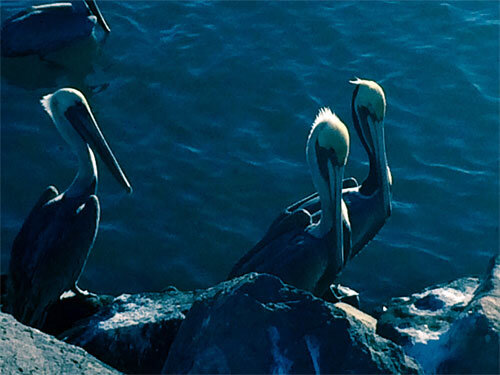Where Are the Whales?
When my husband suggested a camping/whale-watching adventure in Baja California Sur, I was floored. This was the man who sent a friend to keep me company in Botswana to avoid spending two weeks in a tent. So the ROW Sea Kayak Adventures thing came out of left field.
We signed up for what they call the 3×3 Combo: three days kayaking in the Sea of Cortez plus three days with the gray whales in Magdalena Bay.
If you don’t know Baja, it’s a peninsula wrenched away from the California coast by the San Andreas Fault, still moving west at about the speed fingernails grow. The Sea of Cortez fills the gap between Baja and the mainland and is home to one of the highest concentrations of marine mammals in North America. And, by the way, don’t make my rookie mistake. Baja California isn’t in California. It’s in Mexico.
Mountains from the Sea of Cortez
We kayaked between the islands of Danzanta and Carmen, moving camp every day. The kayaking was great, although on one crossing the headwinds were so strong that even paddling for all we were worth felt like going backwards. When we arrived my arms were noodles. I had to be hauled out of the kayak like a bag of wet towels.
Off we go. Ron, as usual, is doing most of the work. | Image courtesy ROW Sea Kayak Adventures
The camps were basic: two-man tents with air mattresses and sleeping bags on the ground, a camp kitchen and one bucket toilet about a million miles away. The scenery was spectacular, the food was good, the company congenial. But no mammals showed up for the party. The whales, dolphins and sea lions living in the Sea of Cortez did not appear to be at home.
Chef Valenti and his camp kitchen | Image courtesy ROW Sea Kayak Adventures
We saw the occasional manta ray leap out of the water (I was always looking the other way), a few Magnificent Frigate Birds (that’s their name, not a description), a couple of Brown Boobies and, way in the distance, a pod of dolphins playing in the sun. But that was about it, except for the pelicans. They cruised overhead like pterodactyls on the hunt and dove into the water like kamikaze.
I never got tired of looking at the pelicans, but the lack of whales was a big disappointment. All that work for a bunch of funny birds? No thanks.
Until our last afternoon on the Sea of Cortez.
Brown pelicans, Mexico’s aerobatic clowns
I’d passed on the after-lunch hike and was sulking on the beach with my Kindle when the radio sputtered. Our group had just sighted five fin whales swimming in convoy. How unfair was that? Now I’d have to figure out what to say when the group came back to camp. Anything I could think of sounded a) sarcastic, b) childishly spiteful or c) both of the above.
Then I felt a peculiar sensation in my chest. The only way I can describe it is “big.” I looked up and saw five enormous backs, nose to tail, processing down the channel. Only a tiny sliver of each back showed, like moving pencil strokes on the water, then gone. Had I been alone I’d have doubted my eyes, but a nearby guide and the feeling in my solar plexus told me they were real.
In that thirty seconds the whole trip was transformed. Sore muscles, midnight trips to the toilet tent and sand in my sleeping bag seemed trivial compared to the feelings the whales inspired in my heart.
And we had yet to see the gray whales in Magdalena Bay.



